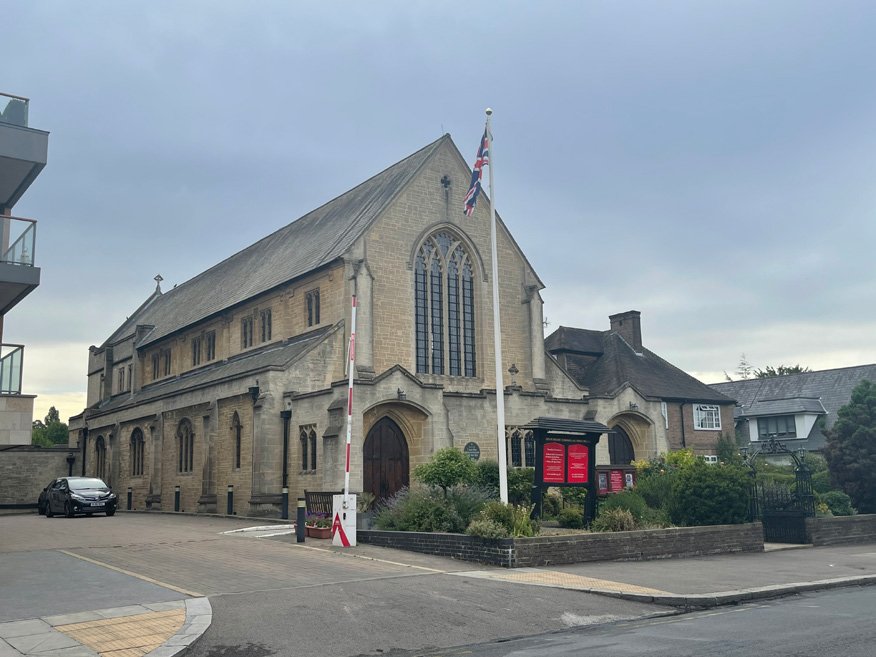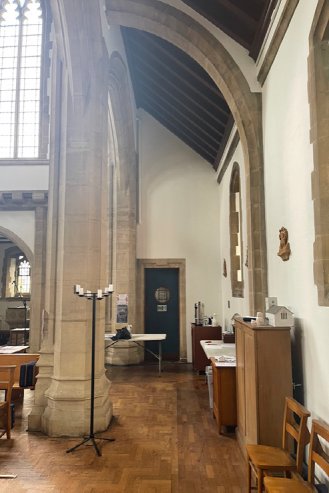 MILL HILL
MILL HILL
ST MICHAEL’S & ALL ANGELS CHURCH
APPLICATION FOR KITCHEN SERVERY
December 2022
Thomas Ford and Partners
177 Kirkdale
London
SE26 4QH
0208 659 3250


CONTENTS
• Combined Statement of Significance & Need
• Preliminaries
• Materials & Workmanship
• Proposed Drawings
• Building work Quotation from
JLA Building Contractors Ltd
| MILL HILL, ST MICHAEL’S & ALL ANGEL’S Combined Statement of Significance & Need Application for the Servery Proposal |
672500/15/KB/JP November 2022 |
 |
Statement of Significance
1.0 Background
1.0 This document has been prepared to support the application for DAC advice and for the Faculty for permission to carry out the installation of new Servery Kitchen at St Michael and All Angels, Mill Hill.
1.1 The last Quinquennial Inspection was put together in March 2022.
1.2 In brief the proposal for a new kitchen and serving station in all is to further amenity offering to the community, giving the ability to serve refreshments and have a more accessible kitchen for the elderly volunteers.
2.0 Aims
2.1 The Statement of Significance aims to establish from sources readily available, a view of significance of the building and place of St Michael’s and All Angels, Mill Hill.
2.2 The Statement of Significance is designed to be a tool which will allow the careful management of change within and associated with St Michael’s and All Angels, Mill Hill.
Summary
2.3 St Michael’s and All Angels is not statutorily listed, however is of special Architectural significance with its presence with Mill Hill Broadway and Flower Lane, and its history of construction gaining prevalence within the community.
2.4 The first design was made by W.D. Caroe in 1916; some of the architectural work was taking place during the war years. This design was too expensive and it was Herbert Passmore’s modification that was accepted by the Building Committee in 1919.
The design is a traditional Perpendicular (late fifteenth century gothic). The whole interior is finished with coombe-down stone dressing and plastered walls. Exterior is coursed ashlar, box-ground stone walking with stone quoins.
2.5 The Statement of Significance will be circulated to the Diocese of London and the members of the PCC as part of the consultation process in connection with the new servery works.
2.6 The Statement of Significance has been drawn up only from sources readily available and any major projects at St Michael’s and All Angels in the future will need to include reassessment of this statement.
The Site and the Church Buildings.
2.0 General information and significance
2.1 From the year 1921, it is learned that it was the wish of the committee to erect the East end first, owing to the cost, it would be found that no funds would be left to provide a permanent Nave. As accommodation was required for 250-300 people; therefore, it was decided to erect three permanent bays of the Nave and the Choir.
2.2 As construction work progressed, the consecration of the first part took place on the eve of the Festival of St Michael. At this time, there were no permanent outer walls to the church and such a situation inspire the people of St Michael’s to ensure the enormous church construction was completed. It was the first new church built in outer London after the Great War (WW1).
2.3 The first design was made by W.D. Caroe in 1916; some of the architectural work was taking place during the war years. This design was too expensive and it was Herbert Passmore’s modification that was accepted by the Building Committee in 1919.
2.4 The design is a traditional Perpendicular (late fifteenth century gothic). The whole interior is finished with coombe-down stone dressing and plastered walls. Exterior is coursed ashlar, box-ground stone walking with stone quoins.
2.5 Owing to the clay nature of the soil, the church is built on a reinforced concrete raft.
2.6 The roof is covered externally with Precelly slates and is supported by steel trusses cased in Oak in a barrel formation.
2.7 Fixtures and fittings on the church walls are made of interesting timber carvings.
2.8 The Font is placed to rear of the church nave and gives an impressive view of the oak-barreled ceiling. There is no chancel arch but the junction with the Nave is marked by a wide traceried rib in the ceiling. The Font is the oldest monument in the building, being from St Paul’s Mill Hill and dates back to 1835.
2.9 In recent years the windows within the nave have been fitted with tinted glass.
2.10 The Church bell is reached by a ladder leading from the Organ loft.
2.11 Within the Chapel, the Sanctuary Arch is placed in a way that disturbs the view of the warmly decorated ceiling. At the time of re-decoration in 1970, it was proposed that the rest of the ceiling in the Chapel be similarly treated but this did not materialise.
2.12 The Nave floor is covered in a particular timber called GURJAN; of which is from the evergreen tree grown in Burma. It has a mellow brown colour and is particularly silent under the tread of feet.
3 The Organ
3.0 The original Organ in the church was built by Bishop & Son in 1875. Later, in June 1947 the Vicar Rev. LH. Yorke stated he had seen an Organ built in 1937 by Kingsgate-Davidson for a private house in Hampstead; of which they purchased and installed into the church; the casework of this Organ still exists.
3.1 In 1953 the Church was to be completed, and it was planned that a new, larger and more versatile instrument would suit the requirements of a larger building. The new instrument incorporated a great part of the existing Kingsgate-Davidson with suitable additions and a greatly reinforced Pedal department. Some pipework was salvaged from bomb damaged city Churches.
3.2 Every Organ has some issues, however it has been likened to a miniature version of a fine Cathedral organ. Unfortunately it is not possible to appreciate the Organ to the full because of the enclosed nature of the loft high up on the North side of the church; where the original larger design of the church would have been wider with lofty aisles which would have permitted an opening from the Organ chamber above the Lady Chapel arch.
3.3 The current Organ sounds remarkably impressive down the church and more so when the church is empty, when a short reverberation period enhances the sound still further.
4 St Michael’s Today
4.0 A new church hall for St Michael;s was developed between 2014-2016 of which was part of the mixed used development with housing above, approved by Barnet’s Planning and Environment Committee in February 2009.
4.1 The church has a warm and welcoming feel, and the team ensure each person is greeted with a smile.
Statement of Need
1 The members of the PCC and the Church congregation have seen a spiritual revival and church attendance has fluctuated. The PCC recognise the hard work and undoubted generosity of the processors.
2 Currently with the increasing size of the Church attendance there has been a need to supply teas, coffees, refreshments and cake and the current facility is not sufficient. There is not cold and hot water supply at the informal tea and coffee station, and a lot of the volunteers to the Church are elderly and are currently struggling delivering water across the nave for the tea/coffee station.
3 The goal is create a solid kitchen servery space that will be sufficient to the larger congregation and events that the church holds and plans to facilitate to in the future.
4 The Current Church Interior As described in the Statement of Significance, the Church has an impressive interior is finished with coombe-down stone dressing and plastered walls with the tea/coffee station being in the North aisle with a view of the cloisters.
5 The existing tea/coffee station is on a temporary table and a wheeled trolley with Coffee and hot water dispensers, which is fine temporarily, however is not sufficient for the sustainable vitality of the church. It is far from ideal and does not pass health and safety measures of the users.
1.1 Currently, there is a simple, long table at the western end of the Nave. A few times a week hot and cold drinks and nibbles are served at various community meetings and church events. The space gets really busy as the table gets surrounded by mingling people and those using the entries to the Nave from the Western Narthex. The food and drink station need to be manned all the time to prevent small children accessing the hot drinks devices.
1.2 The Parish is determined to adapt this space in the most respectful to the building manner, creating a well-ordered arrangement of waist-height joinery units with all appliances concealed from direct view. The unit itself will be made in hardwood with a reconstituted stone worktop for a neat and unified look. The detailing will be borrowed from those of already present at the church and adapted to suit.
1.3 Great care has been taken in the design of the proposed servery to ensure the existing use of the church is retained and the existing doorway is undisturbed in considered with undefined future use. The equipment used to heat water will be low-emission urns with minimal steam generation and the procedure for operating the domestic dishwasher will involve opening only when cold. The existing vent stone ventilation system is in good operational order and will help to maintain air quality conducive to protection of the stained-glass windows.
1.4 The joinery work and electrical and mechanical connections will be carried out to a high quality by experienced locally based specialists with an understanding of the historic fabric of the church buildings.
1.5 The replacement of the existing temporary Servery set-up by a permanent set-up located in the North-west corner of the church will improve the area available for circulation at the entry/exit zone of the building and enhance safety for users. The provision of a suitable electricity supply to the new Servery will have the added benefit of enabling heating and hot water.
1.6 The chosen materials for the proposal have been carefully considered to be in-keeping with the existing material palette of Gurjan timber flooring, light white walls, timber carvings and stone structure. The proposed materials consist of an Oak frame, Oak back paneling, Oak kitchen cupboard units and a stone effect Corian worktop and Servery station creating a warm palette that matches the Nave interior. The sink, tap and all ironmongery will be stainless steel.
Impact of the Proposals
1.1 The proposal is a result of ongoing, unsatisfactory and temporary arrangement being set up at least once a week to provide refreshments. Its location, at the Western end of the North aisle internal entry to the Nave, has been pre-determined as the most suitable to cater for weekly family meetings and ongoing mission events. The current simple form of a long table with a number of trolley unit for coffee and tea urns is far from ideal and barely passes health and safety for the users.
1.2 A new, purpose made, waist-height quality timber servery unit has been designed, so that it creates functional, tucked-away serving area, which is not prominent and aesthetically neutral to the church interior.
1.3 The Servery will provide an area for hot and cold-water supply, dishwasher facility to clean crockery and fridge/freezer appliance to store milk and other beverages. It has been carefully considered to not dominate the area of the church and is the most suitable place for the church and circulating congregation.
1.4 The design has been considered in a way that considers an area to serve and the congregation to circulate, and also if staff need wheelchair access to the coffee station, then wheelchair access can also circulate.
1.5 The existing Vicar is very excited for the proposals are the possibility to improve the experience of the staff and how they can facilitate future church users.
